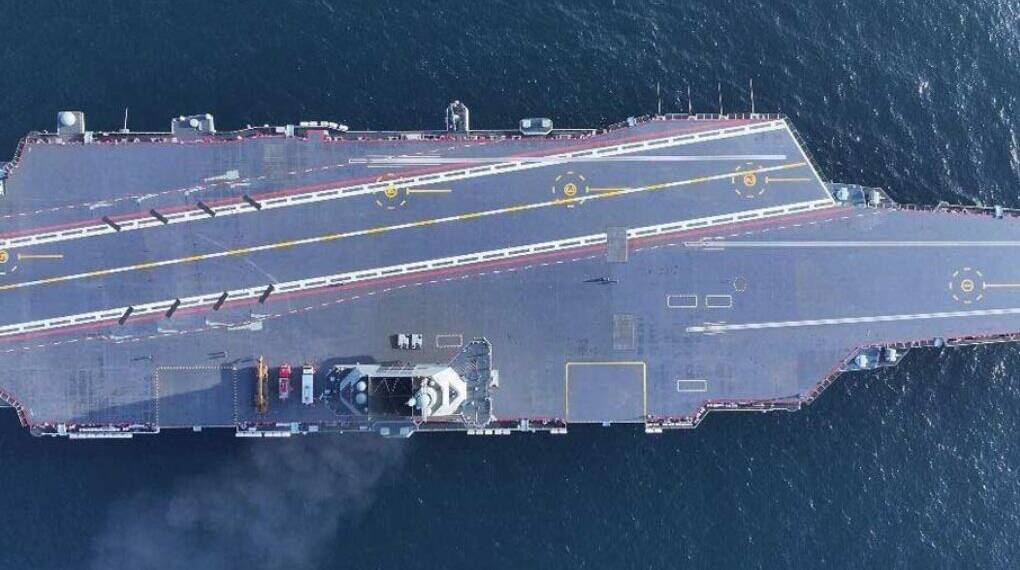China has taken a major leap forward in naval aviation with its latest aircraft carrier, the Fujian, successfully conducting its first electromagnetic catapult-assisted take-offs and arrested landings. The People’s Liberation Army Navy (PLAN) announced on Monday that three carrier-based aircraft—the J-15T, J-35, and KJ-600—have completed the historic trials, marking a milestone in China’s carrier program.
The electromagnetic launch system, or EMALS, until now exclusively deployed on the U.S. Navy’s USS Gerald R. Ford, allows for faster, heavier, and more efficient aircraft launches. By mastering this technology, China narrows the technological gap with the United States, a key player in the Indo-Pacific region, signaling Beijing’s growing naval ambitions.
Historic Flight Trials
According to the PLAN, all three aircraft successfully carried out electromagnetic catapult-assisted take-offs and arrested landings without incident. The state-run Xinhua news agency reported that the Fujian now possesses fully operational launch and recovery systems, enhancing China’s ability to project air power at sea.
The aircraft involved include the AVIC Shenyang J-15T, an upgraded version of the Su-33; the J-35, China’s fifth-generation stealth fighter designed for carrier operations; and the Xian KJ-600 airborne early warning and control aircraft, akin to the U.S. E-2 Hawkeye, providing advanced situational awareness and command capabilities. Video footage shows the jets launching from Fujian via EMALS, landing using the carrier’s four arresting wires, and being moved by elevators to the hangar below deck. The vessel is believed to be operating near Hainan Island in the South China Sea.
About the Fujian
Launched in 2024, the 80,000-tonne Fujian is China’s first domestically built, catapult-equipped aircraft carrier. It can carry a diverse array of aircraft, including fighters, airborne early warning planes, anti-submarine aircraft, and drones.
Having completed more than 100 days of sea trials, the Fujian is on track for commissioning later this year. Once operational, China will for the first time deploy three full carrier groups, a number that rivals the U.S. Navy’s presence in the region.
Since its initial sea trial in May 2024, the Fujian has undergone rigorous testing for system stability, deck operations, and overall operational readiness. Reports indicate that all trials have progressed smoothly, signaling that the carrier could soon enter active service.
Capabilities and Limitations
In terms of size, Fujian is nearly comparable to U.S. supercarriers like the Gerald R. Ford (100,000 tonnes) and Nimitz-class carriers (97,000 tonnes). However, differences remain. While U.S. carriers feature four electromagnetic catapults, Fujian has three, which may limit simultaneous aircraft launches. Analysts also note that the jet blast deflector could interfere with landings, slightly constraining operational efficiency.
Unlike nuclear-powered U.S. carriers, which enjoy virtually unlimited endurance, Fujian relies on steam turbines and diesel generators, restricting its operational range to waters near China. However, the PLAN is enhancing its logistics capability with underway replenishment ships to extend fleet operations farther from home waters.
Strategic Significance
Fujian represents a significant leap over China’s two existing carriers, the Liaoning and Shandong, which employ STOBAR systems relying on ski-jump ramps. EMALS allows China to launch heavier aircraft more efficiently, generating sorties closer to the operational tempo of U.S. supercarriers.
The development carries considerable geopolitical weight. In the context of China’s growing rivalry with the United States, Japan, and other regional powers, the Fujian will play a central role in the South China Sea, East China Sea, and beyond. With tensions over Taiwan and strategic maritime lanes, the carrier strengthens Beijing’s hand in asserting naval dominance in contested waters.
While still smaller and less capable than U.S. supercarriers in endurance and sortie generation, Fujian enables China to operate more independently and project power farther from its shores. The carrier’s advanced capabilities — from fighter launches and early warning surveillance to command-and-control operations — put pressure on neighboring powers like Japan, South Korea, and India, while signaling that the U.S. can no longer assume uncontested naval supremacy in the Western Pacific.
From initial sea trials to electromagnetic catapult launches, the Fujian has demonstrated that China is now capable of operating a modern, EMALS-equipped aircraft carrier. Once commissioned, it will be at the forefront of China’s blue-water ambitions and a game-changer in the strategic rivalry in the Indo-Pacific.
China vs. the United States. China vs. regional powers. The balance of naval power in Asia is shifting — and the Fujian is leading the charge.








